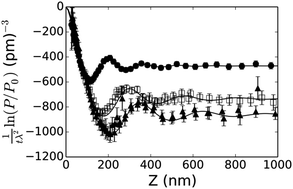Inter-particle correlations in a hard-sphere colloidal suspension with polymer additives investigated by Spin Echo Small Angle Neutron Scattering (SESANS)
Abstract
Using a neutron scattering technique that measures a statistically-averaged density correlation function in real space rather than the conventional reciprocal-space structure factor, we have measured correlations between poly(methyl-methacrylate) (PMMA) colloidal particles of several sizes suspended in decalin. The new method, called Spin Echo Small Angle Neutron Scattering (SESANS) provides accurate information about particle composition, including the degree of solvent penetration into the polymer brush grafted on to the PMMA spheres to prevent aggregation. It confirms for particles, between 85 nm and 150 nm in radius that inter-particle correlations closely follow the Percus–Yevick hard-sphere model when the colloidal volume-fraction is between 30% and 50% provided the volume-fraction is used as a fitted parameter. No particle aggregation occurs in these systems. When small amounts of polystyrene are added as a depletant to a concentrated suspension of PMMA particles, short-range clustering of the particles occurs and there is an increase in the frequency of near-neighbor contacts. Within a small range of depletant concentration, near-neighbor correlations saturate and large aggregates with power law density correlations are formed. SESANS clearly separates the short- and long-range correlations and shows that, in this case, the power-law correlations are visible for inter-particle distances larger than roughly two particle diameters. In some cases, aggregate sizes are within our measurement window, which can extend out to 16 microns in favorable cases. We discuss the advantages of SESANS for measurements of the structure of concentrated colloidal systems and conclude that the method offers several important advantages.


 Please wait while we load your content...
Please wait while we load your content...